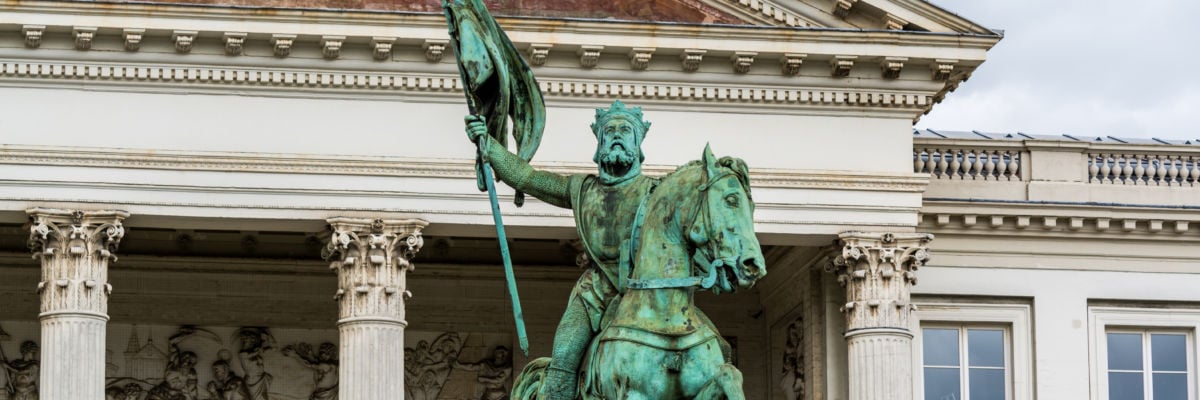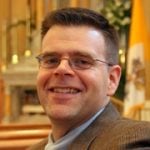
The eleventh century was a time of great turmoil in the Church as it suffered rampant corruption and clerical sexual immorality. Secular rulers vied to control the papacy and local bishops and use the Church for their own profit and gain.
Reformers began a concerted campaign to eradicate ecclesial abuse and free the Church from secular interference. Reform originated at the local level and in monasteries and was shepherded by concerned laity and religious. The reform movement gained new impetus with the election of reform-minded monks to the papacy in mid-century. It was one of these reformers, Pope Bl. Urban II (r. 1088-1099), who launched the Crusading movement to liberate Muslim-occupied Christian territory in the Holy Land, which impacted European society for centuries.
Medieval society comprised those who prayed, those who worked, and those who fought. The ability of the monk and the warrior to perform their tasks relied on the labor of the peasant and craftsman. Social mobility was uncommon yet possible within the Church. Abbot Suger of St. Denis near Paris provides an example. This son of a serf entered the service of the Church and rose to a prominent abbotship, developed the French (Gothic) architectural style, and was appointed regent of France during King Louis VII’s participation in the Second Crusade.
The warrior class protected the monk and the peasant and trained for war from an early age. Familial relationships were paramount, especially within the warrior class, and shaped social interactions.
Godfrey became duke of Lorraine in 1076 at the age of eighteen. Among his property holdings was the famous castle of Bouillon, originally built by Charles Martel, the legendary Frankish military commander who defeated a Muslim invasion force at the Battle of Tours in 732 and the grandfather of Charlemagne.
Godfrey was a member of an eclectic family with a fascinating history. His grandfather, Godfrey the Bearded, was a notorious rebel who fought three times against the Holy Roman Emperor Henry III and was a great friend of the papacy. Godfrey’s great uncle was Pope Stephen X (r. 1057-1058), a member of the papal delegation to Constantinople during the infamous schism of 1054. Godfrey’s parents lived holy and adventurous lives. His mother, Ida of Lorraine, was a pious and devoted woman whom the Church recognized for her sanctity. Godfrey’s father, Eustace II of Boulogne, was married originally to the sister of the English king St. Edward the Confessor. Eustace fought with William the Conqueror during his invasion of England and is depicted on the Bayeux Tapestry.
After Pope Urban called the Crusade at Clermont in November 1095, preachers fanned out across Christendom, exhorting warriors to take the cross. Godfrey relished the opportunity to utilize his military skills for Christ and the Church. He assembled an army that contained several thousand knights and soldiers along with two future kings of Jerusalem. Godfrey knew that the expedition was a unique opportunity, but he, more than likely, had no comprehension that the quest would enshrine his name in history.
After an initial rocky reception from the Byzantine authorities and an imperial demand of loyalty, the assembled Crusade armies (there were four main groups) were transported across the Bosporus in spring 1097 to begin their march to Jerusalem. The first objective was the liberation of Nicaea, site of two ecumenical councils in 325 and 787. Godfrey’s force was in the vanguard and cleared a path through the overgrown old Roman road for the remainder of the army. During the siege, Godfrey’s renown increased in the army thanks to a skilled crossbow shot that killed a troublesome Turkish archer on the city’s wall. The siege of Nicaea lasted six weeks, and its end allowed the Crusader armies time to rest and refit before continuing the campaign.
The second objective of the Crusade was the ancient city of Antioch. The journey from Nicaea to Antioch occurred during the summer of 1098. It was a hellish march, oppressed by the brutal summer heat. Food and water were scarce, death and desertion constant. On this leg of the journey, Godfrey once more achieved notoriety among the Christian warriors when he rescued an unarmed pilgrim from a bear attack. The encounter with the beast left Godfrey seriously wounded. At Antioch, as at Nicaea, the Crusaders settled in for a siege, which was finally broken by a daring commando-type raid at dawn. The Norman Crusade leader Bohemond bribed a tower guard captain to allow a small group of troops entrance into the tower. Sixty warriors, Godfrey among them, climbed a ladder up the tower in the early morning hours. This raid allowed the Crusaders entrance into the city and to secure it before the arrival of a relief army, which they defeated in a subsequent battle.
Before the battle, Godfrey motivated his troops with a rousing speech illustrating his deep faith in Christ:
We are devout worshippers of the living God and of our Lord Jesus Christ, in whose name we go to battle. Our enemies trust in their own strength; we, however, in the name of the living God. Trusting in his mercy, we do not hesitate to give battle to infidels and unbelievers. For we are the Lord’s, whether we live or die.
During the battle, Godfrey displayed his martial skills by killing an armored horseman, cleaving the man and horse in two with one swing of his sword. The Crusade armies marched on the final leg of their journey and reached Jerusalem in the summer of 1099. They began the final assault on the city on July 13, using siege towers and battering rams. Godfrey’s army was in the thick of the fight. Utilizing a four-story siege tower to attack the walls, Godfrey and his brother fought from the top story. They held the city’s defenders at bay to provide time for their troops to climb scaling ladders up the wall. At one point in the attack, several beams in the tower began to give way when Godfrey stepped into the breach to hold the section together with his bare hands.
The attack was successful and the Crusade complete. Godfrey removed his armor, donned a simple linen garment, and walked barefoot to the Church of the Holy Sepulchre to pray.
His armed pilgrimage at an end, it can be surmised that Godfrey de Bouillon looked forward to journeying home to his beloved Lorraine, but the longed-for return proved elusive. The Crusade nobles knew they needed to defend the recently liberated territory and asked Godfrey to remain in the Holy Land as the first Latin king of Jerusalem. Tradition holds that Godfrey rejected the royal title out of reverence to the King of Kings. He reputedly remarked, “I will not wear a crown of gold in the city where the Savior wore a crown of thorns.” Instead, he took the title “Defender of the Holy Sepulchre.”
His reign was short, as the noble warrior from Lorraine died in 1100 after a prolonged illness. This faithful follower of Christ was interred in a tomb in the Church of the Holy Sepulchre that bore the inscription: “Here lies the renowned Godfrey of Bouillon, who brought this whole region under Christian sway. May his soul rest with Christ. Amen.”



